Zoran Milosavljevic on the ImageBlog
Met Opera: Damrau and Camarena Turn 'La Sonnambula' Into a Dream
Damrau is a marvel. Her voice, always crystal clear and delicate, is full of such joy that it spreads to all who hear her. She makes the most difficult passages sound effortless, even as she sings while twirling around a room, trying on a pair of shoes, rejecting a Heidi wig for her own ponytail, or crawling across a tabletop. Her pianissimo notes, barely above a whisper, go straight to the heart.
Camarena is one of the most exciting tenors singing today. He has a strong voice, rich in timbre and nuanced with subtle phrasing and a soaring range. Vocally, he is somewhat reminiscent of Richard Tucker. Physically, he looks a bit like the young Babe Ruth, and he hit a grand slam in the big tenor aria "Perche non posso odiarti," earning a cascade of bravos. This is only his second appearance at the Met. One hopes there will be more.
The Met production of Bellini's tuneful "semi-serious" opera by the stage director Mary Zimmerman was unveiled in 2009. It moves the action from its original Swiss Alpine village in the early 19th century to a rehearsal studio that looks like a SoHo loft where a cast and crew are preparing a modern-day performance of La Sonnambula.
The action then mirrors the original. There is a love triangle that becomes more complicated as the story unfolds. Amina and Elvino are about to be married, but Lisa, who was once engaged to Elvino herself, still carries the flame. Then there is Alessio who is in love with Lisa, but she won't give him the time of day.
Enter a stranger -- handsome, smartly dressed, and clearly rich -- who says he grew up in the village and begins to flirt with Amina, to Elvino's great annoyance. It turns out that the stranger is actually Count Rodolfo, the long lost son of the dead Count, and the locals regale him with tales of a "phantom" that haunts the town and walks only at night.
Given the opera's title, it will be no surprise to anyone that this ghost is none other than Amina who is subject to sleepwalking. Unfortunately, she sleepwalks right into the Count's bedroom at the inn and is discovered there the next morning, further fueling Elvino's jealous rage to the point where he breaks his engagement and is ready to lead Lisa to the altar.
Zimmerman employs several devices common in the legitimate theater, but unusual for opera, to get the audience involved in the action. One is to use the aisles as a stage entrance. During her first sleepwalking scene, Damrau enters from the back of the house and moves trancelike and barefoot down the left aisle before ascending the stage, singing all the while.
La Sonnambula is also an opera that lends itself to innovative directorial touches. Bellini's score calls for considerable interaction between the chorus and the principals, and members of the excellent Met chorus get several chances to display their acting skills in a number of scenes, talents that a stage director like Zimmerman can exploit to the fullest.
That is even more true for the principals. Long gone are the days an opera singer can make his or her mark, belt out a few high notes and earn the plaudits of an adoring audience. Implausible as most opera plots are, they are no less so than what is offered on TV and the difference in making opera an exhilarating evening of theater and a staged vocal recital is in the acting.
Damrau and Camarena have excellent chemistry. Just the way they gaze into each other's eyes is enough to convince an audience they are in love. Their first reconciliation over Elvino's jealousy is a duet ("Son geloso") that ends with Damrau climbing up on a table and crawling over to Camarena. It is a playful and sexy scene that enhances the words they sing.
Marco Armiliato conducts the excellent Met Orchestra with a sure understanding of what both Bellini and Zimmerman are striving for. The rest of cast add fine performances, notably a lovely turn by Rachelle Durkin as Lisa and a solid performance by Michele Pertusi as Count Rodolfo.
Legendary Queen of Pop Sings in Queens, NY
I walked into the auditorium astonished to see over 2,000 people spanning all ages and generations. The minute Googoosh blessed us with her beautiful voice, tears started rolling down my face. It was such a nostalgic experience. I was with 4 of my Iranian girlfriends, a Muslim, Christian, Bahai, and Jew, ready to enjoy our night, but there I was, crying. Can you imagine going to a concert and crying from memories of your youth? Hundreds of smart phone cameras were flashing throughout the audience, colorful lights brightened up the stage, and the music coming through the advanced sound system charged us all with what seemed like everlasting energy. Through the power of music, Googoosh was able to bring up memories of the sweet childhood I had in Iran. Those who grew up in my generation would go to see her perform, anxious to see what earrings she'd be wearing, how her hair was styled, and the color of her miniskirts. Googoosh, to us was like Iran's Madonna and busted moves like Michael Jackson. She was banned from bringing entertainment to her faithful Iranian fans since 1979, and was now singing to an audience spanning 3 generations with her freedom in America. I felt like we were travelling time and it was so bittersweet.
As I looked around, wiping my face from tears, I took note of how diverse Googoosh's audience was. College students who were not yet born at the height of her career in Iran, were dancing with each other, and I had a flashback of myself dancing with my friends in the golden days of our youth. I saw an elderly lady tapping her cane to Googoosh's tunes. Others around me were smiling, with tears trickling down their face too. Googosh greeted the audience with "Happy Nowruz and Happy Purim!" and I thought about the resilient diversity of Iran when I was growing up. Would Iranian youth ever be able to hear Googoosh in Iran again?
Even Googoosh's American band was full of diversity. We were taught to embrace diversity, a value long instilled in us since King Cyrus' time, and it was evident Googoosh upheld this legacy. Her guitarist and keyboardist were from Iran, pianist and bassist from Armenia, flutist from Venezuela, American drummer and producer, and Puerto Rican percussionist. They harmonized all their sounds to produce a Turkish sound, which Googoosh channels from her father's ancestry.
Out of all the changes experienced in Iran after 1979, I believe the loss of music such as the music of Googoosh is one of our more tragic losses. Experiencing the joy of her music once again reminded me how necessary it is for people to be able to enjoy music in their lives, not only the freedom of listening to their genre of choice, but of performing as well. Music has therapeutic abilities and is a healthy way to express grievances and joys. Music documents and brings emotions to life. I can imagine the people of Iran, especially the young people, long for the freedom music can bring into their lives.
Even after being banned from performing in Iran, Googoosh continues to sing about her love for her country through her newfound freedom of touring in America and around the world. She sang her newest song for us, dedicated to child labor. According to Article 27 of the UN Universal Declaration of Human Rights,
(1) Everyone has the right freely to participate in the cultural life of the community, to enjoy the arts and share in scientific advancement and its benefits
(2) Everyone has the right to protection of moral and material interests resulting from any scientific, literary or artistic production of which he is the author
In honor of Women's History Month, I want to highlight Googoosh, this legendary singer of Iran, and her dedication to pursuing music and the arts. She has enchanted Iranians for over 6 decades. If her concerts around the world have such a positive impact on people, can you imagine if she has a concert in Iran what joy it would bring to the people? Do you all think President Rouhani could honor Article 27 and allow Googoosh a homecoming concert?
The Best Arts Job in the World
Not because I have any doubt she will do a spectacular job -- Deborah is smart, creative, kind and experienced. I am confident that she will bring new ideas and programming to the Center and will enliven it for our audiences everywhere. I cannot imagine anyone in whom I would have more confidence.
Rather, I am ambivalent about leaving the Center.
In truth, I have been planning this move for years. I believe that a presenting organization needs a new leader every decade or so and, by that measure, I have far outstayed my welcome. (In fact I had planned to leave in 2011 but the affiliation with the Washington National Opera changed my plans.)
But running the Kennedy Center is the best arts job anywhere and that is the root of my ambivalence.
Where else does one get to create programming for such a wide range of art forms -- symphonic music, opera, ballet, contemporary dance, theater, chamber music and jazz -- not to mention the multi-disciplinary festivals, including our huge international festivals? With more than 2,000 performances each year and a substantial programming budget, one is only limited by one's imagination.
Where else does one get to manage an education program that reaches children in all fifty states? This year alone, 11 million people will have an opportunity to engage with the arts thanks to Kennedy Center programming.
Where else does one get to participate in the range of special events -- from the Kennedy Center Honors to the Mark Twain Prize to, my favorite, the informal July 4th celebration on our roof -- with the very best view of the fireworks imaginable?
Where else does one get to collaborate with several national volunteer boards with passionate and engaged representatives from across the nation - not to mention a main board with fourteen members of Congress, three Cabinet secretaries and a remarkable group of patrons?
Where else can one, literally, collaborate with the world? Washington, D.C. is the home to every ambassador to the United States -- this gives the Center remarkable access to artists, events, programs and ideas that span the globe.
With all of these remarkable assets -- not to mention a tremendous staff and a loyal audience - one is never finished as the chief executive of this institution. One merely has one's opportunity to make a difference and then pass these great assets to someone else with another vision.
I, for one, cannot wait to see what Deborah does with the Kennedy Center. I hope she has as much fun as I have had.
I know I will be jealous that she conceived of programming I could never have imagined; and I also know that in a decade or so, when Deborah is ready to pass on the mantle, she will feel just as ambivalent as I do today.
Philip Roth, Bound and Unbound: An Interview with Claudia Roth Pierpont
In five hundred twenty-five thousand six hundred minutes /
How do you measure, a year in the life?-- Jonathan Larson
I was so blue after helping to plan, and ultimately attending Mr. Roth's 80th birthday party last year in Newark, New Jersey, that on March 20, 2013 I adopted a rescue boxer puppy from Northeastern Boxer Rescue. It seemed that nothing in my extended future would be able to top the event of Philip Roth's 80th, so I took into my home from a kennel one of the most difficult puppy breeds known to man. We named the puppy Ajax, which is somewhat ironic, given that he was scrawny and uncoordinated, making living with him all the more difficult. As it happened, with all of his needs and misdeeds, however, Ajax distracted me from what I had internalized to the core: That Philip Roth is retired from writing novels, that his commemorative birthday is done, that he is now free to recede into his personal life as he likes. He owes nothing, anymore, to me or to you.
Without published novels, galas, interviews, awards dinners: how do you measure a year in the life? The question has been on my mind this week, as this Wednesday marks Philip Roth's 81st birthday. The question comes to me from Jonathan Larson, whose lyric is from the hit musical Rent, itself a text deeply aware of loss in the modern age. Something tells me that Mr. Roth would not appreciate my juxtaposition of his life with those portrayed in Rent. Nonetheless, as I look back in the last year of Roth's life, I wonder how he might have measured it -- if he had any interest in measuring it at all.
As it happens, just because one stops publishing novels does not mean that the interviews, galas, and awards dinners will stop. Roth's interview with Daniel Sandstrom that appeared in the March 16, 2014 New York Times book review is evidence of that. Not only does this interview prove that Philip Roth remains, at least partially, in the public eye; it also proves that he continues to write in the form of flawlessly constructed answers to carefully rendered questions. In response to Sandstrom's question about Roth's retirement, Roth says: "Morning after morning for 50 years, I faced the next page defenseless and unprepared. Writing for me was a feat of self-preservation. [...] Now? Now I am a bird sprung from a cage instead of (to reverse Kafka's famous conundrum) a bird in search of a cage. The horror of being caged has lost its thrill. It is now truly a great relief, something close to a sublime experience, to have nothing more to worry about than death."
Here and throughout this interview, Roth is at his writerly best. Even though Roth has retired from writing fiction, he has not retired from writing full stop. He still has the magic: the sentence cadence, the fluidity, the prosody, that voice. But that is not to say we still don't miss the fiction.
Further, the appearance last fall of Claudia Roth Pierpont's Roth Unbound: A Writer and His Books served to incite even greater enthusiasm for Roth's published works and to inspire a retrospective reading of his canon to date. I had known Pierpont's previous work, Passionate Minds: Women Rewriting the World, a Finalist for the National Book Critics Circle Award for Criticism. It is like her recent Roth book in that the former seeks to depict "lives in which success is hard-won, retreat and even breakdown are common, love is difficult, [....] lives in which all that is ever certain is that books and plays and poems are being written" (xiii). For Roth, too, success was hard won, love was difficult. One certainty we, as his reading public once shared, is that he was writing novels. But now there appears to be a new certainty in his life: freedom; "the struggle with writing is over," as he told Charles McGrath.
For Pierpont, Roth Unbound looks back to Roth's writing life. It "is fundamentally an examination of Roth's development as a writer, considering his themes, his thoughts, and his language. By necessity, it covers an enormous span" (5). Here, too, showing how Roth's friendship affected her and her work, Pierpont writes: "But Roth's retirement is also a precondition for the somewhat hybrid form this book has taken, because of his own considerable contributions to its pages: memories, observations, opinions, thoughts and second thoughts, jokes, stories, even songs. To put it simply, he had the time to talk about his work because he wasn't doing it anymore. And it was exciting to look back on a lifetime's production that even he himself had not yet time to sum up" (5-6).
That production over the course of a lifetime had a cost -- sweating over sentences, isolation, time and more time. Roth represents himself to Pierpont as not unlike E.I. Lonoff, in The Ghost Writer, who spent so many days turning sentences around (122).
But after Nemesis, after a career spanning over fifty years, Pierpont tells us: "He was afraid he would become depressed, would suffer from the lack of occupation, would be unable to cope with life without the daily application of his energies to the written page. But none of these things happened. He was utterly surprised to find that he felt free" (324).
As Pierpont's October 7, 2013 essay for The New Yorker reveals, one of the freedoms he seemed sure to pursue would be to spend time with friends. It is significant that her New Yorker essay takes up, in particular, the subject of Roth and his friends: Milan Kundera, Veronica Geng, Saul Bellow, John Updike. As Pierpont surmises: "One can't laugh as much as Roth has laughed in his life without accumulating friends" (31).
Just as Pierpont's book takes up Roth's powerful friendship (in both senses--the emotional power of the friendship, the social power of the friends) with Veronica Geng in the chapter entitled "Ghosts" (280-93), the New Yorker piece turns its attention there as well, revealing that Veronica Geng an editor at The New Yorker in the late 1970s, had become an early reader and champion of Roth's 1979 novel, The Ghost Writer. As a result, The New Yorker published The Ghost Writer in full, over two installments in the summer of 1979 (30). Pierpont reveals here that Geng's illness is reflected through the dying Amy Bellette in Roth's much later novel, Exit Ghost--explaining how, in his personal life, Roth cared for Geng during her illness and hospitalization, ultimately by providing her with company and helping to cover her medical costs. Just as Geng was an early supporter of Roth's introduction of Nathan Zuckerman in The Ghost Writer, Roth would pay homage to Geng in his last Zuckerman novel, Exit Ghost. However, Pierpont is careful to make clear here: "They were never lovers, Roth emphasizes, but they came to love each other" (34).
How does one measure a year in the life? Larson's answer is similar to Roth's as reported by Pierpont's work: "How about love?"
Even Roth's alter ego Nathan Zuckerman struggles to balance his love for writing with his desire to find love for something outside of himself. This becomes clear very early on in Exit Ghost when he adopts, for a brief time, some kittens. As Zuckerman recalls: "He'd brought the cats on a Thursday. I kept them through Sunday. During that time I did virtually no work on my book. Instead I spent my time throwing the cats their toys or stroking them, together or in turn in my lap, or just sitting and looking at them eating, or playing, or grooming themselves, or sleeping. [....] When I awoke in the morning the first thing I did was rush to the door to see them. There they would be, just beside the door, waiting for me to open it."
Although Nathan Zuckerman has to give up his rescue pets because they are, as all tend to be, a distraction, maybe perhaps now Mr. Roth has time to rescue kittens. We know he has time for friends. It seems Roth has this coming to him. It has been, I imagine, quite a year in the life. And we wish him many more.
In the meantime, I leave you with a conversation I shared with Claudia Pierpont following the appearance of her recent book. I am struck by the ways in which Pierpont's responses to my questions have anticipated a new future for Roth, even as she looks back to the past -- not only to Roth's past but also to their shared past of discussing the topics in her book. If nothing else, these responses have a vested interest in how one might measure a year in the life.
Although I am very fond of your eloquent chapters discussing Roth's individual works, one of my favorite parts of Roth Unbound is the last section: "Afterthoughts, Memories, and Discoveries." Both you and Mr. Roth are presented so charmingly in these lovely and seemingly random encounters. It occurs to me though that you must have had to grapple nearly daily with decisions about what to include ultimately and what material to leave out. How did you make these kinds of choices?
To my mind, all of these little stories have some bearing on his writing -- although I wanted these final stories to garnish the book, so to speak, with a sense of what it's like to be in his company, that's the reason I chose these particular ones. The opening Brando-as-Antony story is partly just a link from the end of the previous chapter, but it also says something about his uncanny abilities as a mimic, his memory for voices, and his natural instincts as a performer. His own reflections on his early work, or on Maggie's influence, or on why people may go into literature... and on through the final story about musical countervoices: informal and breezy as these stories are, they were chosen to shed some final light on both the man and the work.
What was it like working so closely with Philip Roth on the book, especially those moments when he revealed personal connections that would help illuminate our reading of his fiction? Were you ever worried about "getting people wrong" -- something Nathan Zuckerman says is inevitable in American Pastoral? How do you avoid sometimes slow-moving, writerly paralysis that comes with the fear of getting people wrong in order to produce such an eloquent, effective book on Roth--knowing particularly that Roth, as a collaborator in the project, will read it in the end?
Working on the book with Philip Roth was a tremendous pleasure. He was generous, funny, and (as far as I know) quite open. I asked questions, I listened, and we sometimes had long discussions about the books. But I really did keep him out of mind when it came to putting all the material together and to writing the book. I had to pretend to myself that he would never read it: this seemed to me the only possible way to write the book I wanted to write. In my twenty years of journalism, this is the way I have always worked. In fact, there has only rarely been even a possibility that my previous subjects would read anything I wrote, so this approach seemed quite natural to me. As for getting people "wrong," that's always a risk and, as you know, is one of Roth's great subjects. In the introduction, I raise the issue that he occasionally expressed different thoughts on a subject at different times. And when this happened, I let the reader know: for example, in the anecdote in the last section about Maggie's influence on his writing, or in his reference to a couple of his books -- "Sabbath's Theater," "American Pastoral" -- as an "outpouring," even while he talks about how very hard he worked on a daily basis to get the results he got.
Despite the fact that you address the "hybrid form of the book" and clarify at the end of the introduction that it "is about the life of Philip Roth's art, and inevitably, the art of his life," why do you think that Roth Unbound is sometimes confused as a biography? What would you say to those readers? How might contemporary readers generally distinguish a book about the art of life, on the one hand, and the hybrid form you describe in the book's introduction?
The book is about both the work and the life because they are so tightly intertwined -- this is true of any artist's life and work, of course, but especially so in Roth's case. I hope that readers will come away from the book with as full an understanding of the man as of the work. Throughout, there are many, many points where biography bears tellingly on the books. There are even some chapters -- the Prague chapter, for example -- that are primarily biographical, in part because so little was known about this fascinating period in his life, but also because of the immense effect the widening of his experience in these years had on the work to come. It's a careful but somewhat intuitive balance that I tried to strike in different ways from chapter to chapter, depending on what seemed right for the period and the book under discussion. But it is always the work that is my primary subject: it's the "illumination" of this great body of work that I'm always heading for and hoping for. As for the term "hybrid": I don't know of any standard biographies (or literary studies, for that matter) that include as much of the subject's voice as I was (luckily!) able to include in Roth Unbound. Being able to preserve his thoughts on so many of his books, on his process, on the people in his life -- this seemed to me not only a privilege but something of a historical responsibility, once I realized that it was going to be possible.
Thank you, Claudia Roth Pierpont. And to you, Mr. Philip Roth: We wish you the very happiest of birthdays and many more to come.
This post has been modified since its original publication.
10 Food Trucks You Need To Visit In Austin, TX
1. Micklethewait Craft Meats
Why: Texans love their brisket -- the definitive meat for Texas BBQ. Micklethewait's brisket is tender, juicy and has just the right amount of seasoned crust. Do yourself a favor and go. to. here. Bonus, in its normal location on Rosewood Ave., Micklethewait is only five minutes away from another popular Austin BBQ spot notorious for its hours-long wait times.
Must-order Item: The Frito Pie is the must order item at Mickelthewait. A heartier version of the classic frito, chili and cheese dish, Mickelthewait tops their pie with two large lamb-chorizo sausages. This dish more than any other was a conversation starter among other hungry Southbyers.
(During SXSW, the truck is located at the SouthBites food trailer park at 604 Driskill St)
2. East Side King
Why: You can't have completed a food truck tour of Austin without a visit to the East Side King truck. East Side King is the creation of chefs Paul Qui (winner of Top Chef Season 9) and Moto Utsunomiya. The chefs are inspired by "Asian cultures, rock bands and Austin's laid-back, experimental and fun-loving vibe." The trucks are covered in the artwork of Peelander Yellow and embody Austin's creative, colorful and free spirit.
Must-order Item: The beet home fries at Eastside King are insane. The beets are first roasted which gives them a slightly sweet flavor and soft texture. They are then fried to get the crispy outer crust and served with a tangy mayo. Sweet beets and creamy mayo, is there really more that needs to be said?
(During SXSW, there are several trucks across the city as well as the location at the SouthBites food trailer park at 604 Driskill St)
3. Little Lucy's Mini Donuts
Why: This relative newcomer to Austin's food truck scene definitely delivers on the sweet treats. Also, the truck is one of several businesses in Austin that accept Bitcoin as a form of payment.
Must-order Item: You must get the cinnamon sugar mini donuts in a big bag. The donuts also come in small bags, but please just get the big bag and save yourself the second trip to the truck. Actually, you might make a second... or third trip even with the large bags because these bite-sized donuts are the most perfect light, crispy pillows of deliciousness that melt in your mouth. They are reminiscent of funnel cake and I want them always.
(74 Rainey Street)
4. Veracruz All Natural
Making fresh tacos until 3am at 6th and Waller! #SXSW pic.twitter.com/BPwyo8kzH7
-- Veracruz All Natural (@VeracruzTacos) March 14, 2014Why: In Texas, we eat tacos all day -- breakfast, lunch and dinner. For those of you that do not understand the concept of breakfast tacos (which are different than breakfast burritos), do yourselves a favor and get educated at Veracruz All Natural.
Must-order Item: The homemade tortillas, hot sauce and fillings of potatoes, egg, cheese, beans and bacon make these the best breakfast tacos in town.
(1704 E. Cesar Chavez)
5. Chi'lantro
Why: Chi'lantro does the fusion cuisine that permeates Austin's food truck scene right. The Korean-Mexican hybrid is just what you want for late-night snacking and combines two of the most perfect foods -- tacos and kimchi.
Must-order Item: The kimchi fries are smothered in cheese, sriracha and a creamy "magic" sauce. They are then topped off with -- pay attention -- caramelized kimchi and Korean BBQ. This sweet, tangy, savory and spicy dish is one of my favorite food experiences.
(During SXSW, there are several trucks across the city as well as the location at the SouthBites food trailer park at 604 Driskill St)
6. Hey Cupcake!
Why: Hey Cupcake! was one of the first (now ubiquitous) silver airstream food trailers in Austin. As the name would suggest, they serve large, richly wonderful cupcakes. Bonus, if you just HAVE to have cupcakes and cannot make the trip to the truck... they will deliver the goodness to you.
Must-order Item: For those of you with a sweet tooth, the red velvet cupcake is to die for, with its moist, soft cake and sweet cream cheese frosting.
(The original location is on 1511 S. Congress)
7. The Peached Tortilla http://thepeachedtortilla.com/
Why: The Peached Tortilla combines Southern and Asian flavors to perfection. The truck is so popular that The Peached Tortilla will open a brick and mortar location in Fall 2014.
Must-order Item: The BBQ Brisket Burrito is stuffed with dry rubbed brisket, cilantro lime rice, creamy slaw and a smoky roasted peach BBQ sauce. And as if this burrito couldn't be any more perfect, it also includes everyone's favorite--a fried egg. If you are in search of a hearty meal, eat this.
(During SXSW, the truck is located at the SouthBites food trailer park at 604 Driskill St)
8. Hey! You Gonna Eat or What?
Why: Hey! You Gonna Eat or What? is the official winner of the 2013 Truck by Truckwest Taste-Off. This food truck serves up large sandwiches and lots of 'tude. To the unaccustomed, the snarky chefs can be abrasive at first but that's just part of the experience. They always ensure to come out and make sure you are enjoying your food and that you leave well fed and happy.
Must-order Item: The Shiner Bock Monte Cristo is THE sandwich to order and the reason behind the truck's 2013 win. This humongous sandwich is stacked with cheddar, provolone, mesquite-smoked turkey and pit-smoked ham and then fried in batter made from Texas' finest brew Shiner Bock. Topped off with a dusting of powder sugar and a side of cherry-fig jam, this sandwich will leave you stuffed. Power through your food coma by walking along South Congress and take the opportunity to visit Austin's weird and wonderful boutiques.
(1318 South Congress but they will move locations shortly to Zilker Park)
9. Gourdough's
Why: Gourdough's specializes in some big, fat donuts. These donuts are not for the faint of heart. At their pub location, they serve donut burgers, which will fill the donut-burger sized hole in your heart. It literally completes you.
Must-order Item: The Flying Pig donut is topped with bacon strips and covered in a maple glaze. In one bite, you will get all the breakfast flavors you need. Mmmm, donuts.
(During SXSW, there are several trucks across the city as well as the location at the SouthBites food trailer park at 604 Driskill St)
10. Torchy's Tacos
Why: Torchy's Tacos has damn good tacos, enough said. Austinites take their tacos seriously and everyone has their favorites, but my loyalties lie firmly with Torchy's.
Must-order Item: You cannot go wrong with any of Torchy's offerings, but do try the Trailer Park taco. This taco is filled with fried chicken, green chiles, pico de gallo, cheese and poblano sauce. Order it trashy and they will replace the lettuce with their queso. That's right, they will cover your taco in queso. For the vegetarians, the Fried Avocado taco is your go-to. Be sure to order a side of their queso as well. This cheesy, gooey wonderfulness was recently voted best queso by Austinites.
(1311 S. 1st as well as several brick and mortar locations across the city)
Whether you're in town for SXSW or planning a visit, you have not experienced Austin until you have done so through a tour of food trucks. Get out there, get weird and eat some dang tacos -- preferably, all day.
SXSW Interview: Stars Natalia Dyer and Peter Vack on Complicated Young Love in I Believe in Unicorns
That's what makes I Believe In Unicorns such a refreshing change of pace.

In Leah Meyerhoff's feature debut, which premiered in the narrative competition this month at the South By Southwest Film Festival, newcomer Natalia Dyer plays Davina, a 16-year-old small-town girl who feels trapped as the primary caregiver for her disabled mother. Her only outlet is a rich and whimsical fantasy life (yes, it involves unicorns) -- that is, until she meets Sterling (Peter Vack), a charismatic older boy who offers Davina adventure, romance and a perceived way out. Best of all? She doesn't have to take care of him, at least not at first. Once they effectively run away together, however, his own dysfunctional past comes into play, and Davina must figure out how to improve her reality all on her own.
In the same way it's often said that no one tells the truth about childbirth, most coming-of-age films shy away from showing the often unpleasant realities of sexual awakening -- in truth, sexual acts can be messy, complicated and painful, both physically and emotionally. Unicorns tackles the bewilderment head-on, which makes it a must-see for teenage girls contemplating their sexual future. The film will also cause us women of all ages to remember those 'bad boys' in our pasts -- the ones for whom we always made excuses, no matter how badly they treated us in public. (We just knew they had hearts of gold.)
Dyer (who was actually 16 when she filmed the movie -- another refreshing touch) and Vack are dynamite young actors on the verge of major career breakthroughs. She will soon appear as the daughter of Kyra Sedgwick and Tim Daly in the sci-fi thriller After Darkness, and he stars in the SXSW Grand Jury winner Fort Tilden and is one of the leads in the new Amazon drama "Mozart in the Jungle." We caught up with the pair in Austin on the day after the film's premiere.
Learn more about the film and its Kickstarter campaign.
Like I Believe in Unicorns on Facebook.
Follow @UnicornsMovie on Twitter.
Drummer Matt Wilson Summons All to His Gathering Call
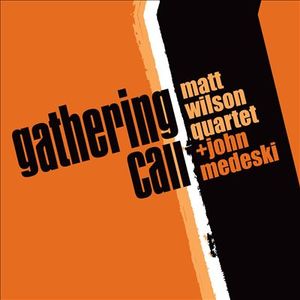
Matt Wilson is a case in point. Wilson is a celebrated drummer whose resume speaks for itself. Wilson made his bones with saxophonist Dewey Redman and in Charlie Haden's Liberation Orchestra. Along the way he has lent his sideman talent as the first call drummer for piano trios led by luminaries like Denny Zeitlin, Bill Mays and Paul Bley. In the various iterations of his own groups, usually quartets, Wilson has consistently shown the ability to create a steady stream of creative music that spans the gamut from hard-bop to the avant-garde, with his music always retaining an inherent sense of joy, a Wilson trademark.
On Wilson's latest, Gathering Call, the prolific drummer has enlisted the cornetist Kirk Knuffke, the reed player Jeff Lederer, bassist Chris Lightcap and guest pianist John Medseki. The music can be traditional big band with a contemporary twist as in the opener Duke Ellington's "Main Stem" where Knuffke can sound like Lee Morgan and Lederer takes on a sound like Gene Ammons big boss tenor to great effect.
The music can be playfully raucous, like on Wilson's three compositions "Some Assembly Required," "Gathering Call" or "How Ya Going?." Wilson is a practitioner of the art of rhythmic chicanery where he uses various sounds and stick techniques to create a cacophony of clicks, bangs and splashes all brilliantly timed and masterfully in tune to the music. The iconic saxophonist Lee Konitz, who has played with Wilson, was quoted saying "I don't think I've ever heard him play an unmusical hit on the drums and cymbals." All the while Wilson deftly interjects just the right amount of humor into his music.
The music can embrace old style swing, like on Duke Ellington's rarely played "You Dirty Dog" where Knuffke plays with polished style in contrast to Lederer's salty tenor solo. Or as on Charlie Rouse's wonderfully evocative "Pumkin Delight," the music is evocative of the Blue Note hard bop heydays.
The music can also be beautiful, like on Wilson's shimmering "Dancing Waters," where bassist Lightcap is featured on some impressionistic playing, or on Butch Warren's hopeful "Barack Obama," where John Medeski's piano layers a cascading shower of notes and Lederer's warm clarinet tones mesh synchronously with Knuffke's moving cornet.
The music can be delicate and uplifting, like on Wilson's "Hope (For the Cause)" which features some subtle piano work by Medeski, showing the sensitive side to this player, often associated with his hard driving organ-led trio Medski, Martin and Wood.
The music can be heartfelt and contemporary like on the beautifully rendered version of the Beyonce tune "If I Were a Boy," a highlight of the album. The album ends with a piece of Americana, the quietly rendered duet between Wilson and Medeski on the traditional song "Juanita." The song transports you to an age of simplicity and honesty that has its own special appeal. With so much diversity in music all expertly played, Gathering Call is another addition to Mr. Wilson's growing joyful and creative repertoire that should be listened to and relished.
274 Faces in 30 Seconds
Michelle Berc, the curator and owner of C:F has asked me to photograph the event a few times before, but this was a little different because it needed to be part of the show.
So... I wandered around as the show began and shot these portraits, then loaded them on to a laptop via Final Cut Pro and projected them huge on a wall. As the night progressed, more got added into the mix until this ended up being the final sequence.
I love how it turned out.
Thanks to Michelle Berc and Liana Bandžiulytė for helping this happen.
John Tweddle and Ken Price at Kayne Griffin Corcoran (Photos)
As part of my ongoing survey of opening exhibitions, here a few highlights from that night as part of my N(art)rative photo series. Here is EMS N(art)rative One.

Ken Price Unit 6 from Happy Curios, 1972-1978. Photo by EMS
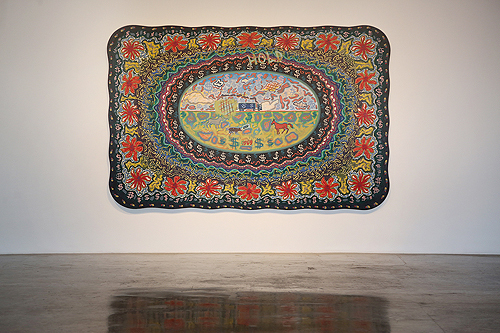
John Tweddle Time Bomb, 1969. Photo by EMS

30 mins prior to the opening at KGC. Photo by EMS
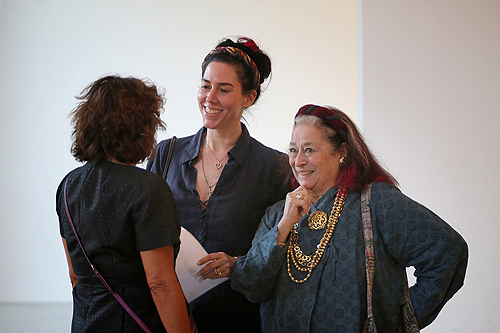
Jennifer and Joan Quinn. Photo by EMS
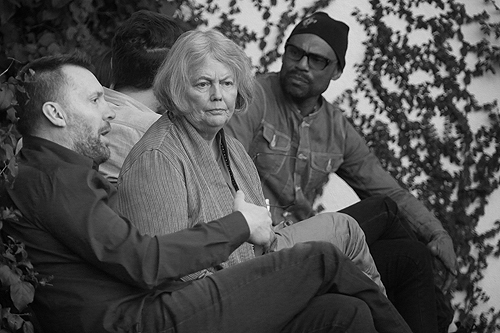
Bill Griffin and Alanna Heiss (left and middle) Photo by EMS
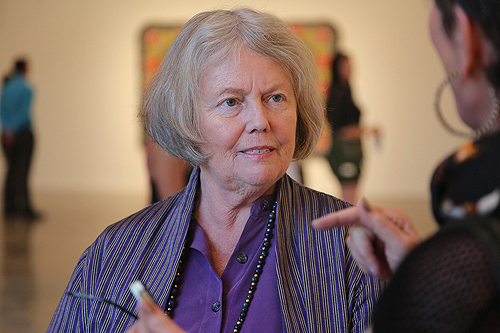
Curator Alanna Heiss. Photo by EMS
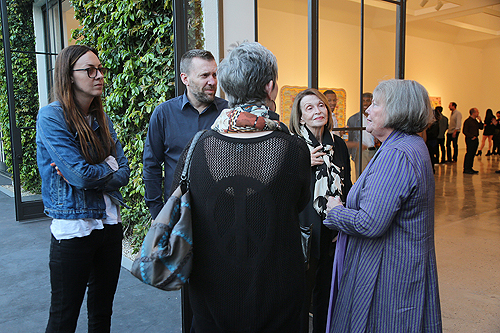
Maggie Kayne (left), Bill Griffin and Alanna Heiss (right). Photo by EMS
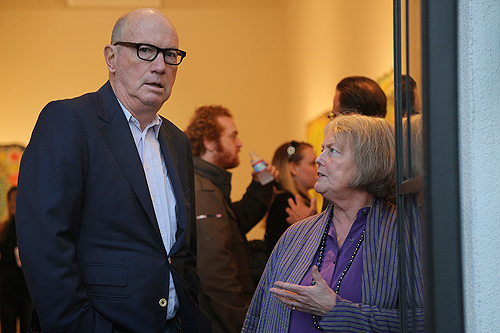
Jim Corcoran and Alanna Heiss. Photo by EMS
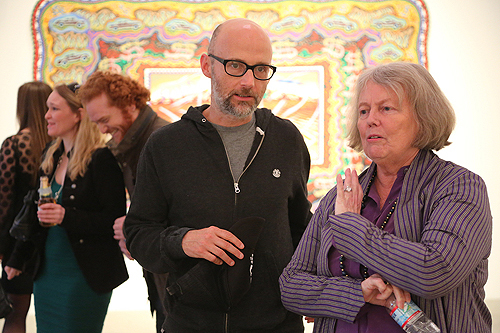
Moby and Alanna Heiss. Photo by EMS
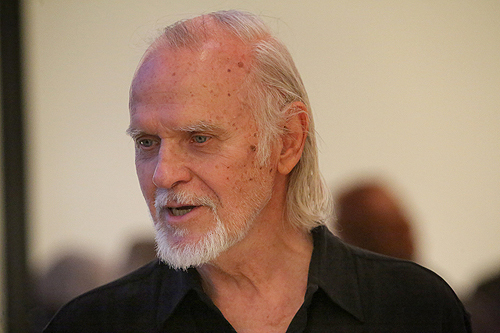
John Tweddle. Photo by EMS
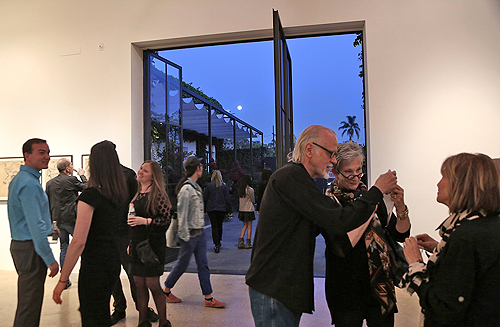
Full moon outside of the opening. Photo by EMS
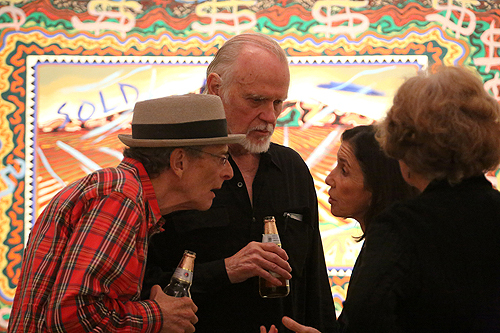
John Tweddle (center). Photo by EMS
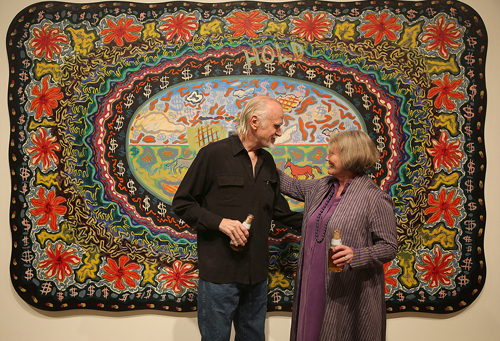
John Tweddle and Alanna Heiss. Photo by EMS
32 Magical Photos of Ireland
Need more Irish goodness? Wish granted.
J. J. Grandville and His Fantastic Creatures
J. J. Grandville, the illustrator, was not a politician or philosopher but a storyteller and even, arguably, the inventor of the graphic novel. In most of his books, the printed words do little more than summarize a story, and the pictures really tell it. They give new dimensions to what might otherwise be stereotypes. People are bestial while animals are human. Comic characters are sad, and tragic ones are funny. Nothing is ever what you expected.
Grandville generally preferred not mammals, which might have seemed a bit too "human" to him, or even birds but reptiles, amphibians, insects, arachnids, invertebrates, plants and machines as characters in his dramas. His animals dress in human clothing not to reveal their basic humanity but, rather, their (and our) essential strangeness.
Very few other artists have been able to fuse human and bestial features so completely, to a point where it is impossible to say which is prior. Animals, even plants and machines, in his work, share the human capacity for corruption, yet perhaps that is just another way of saying human beings share their innocence.
Here are a few of his illustrations, accompanied by brief notes and commentaries (Viewing this full screen is recommended, since the detail is often quite fine.):
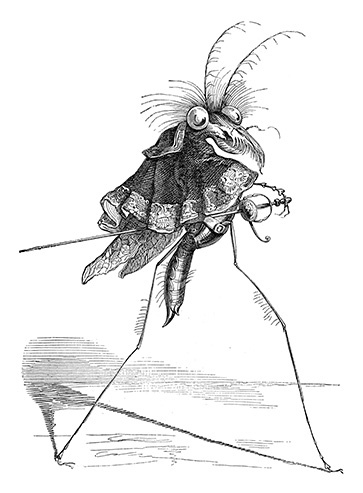
The misocamp, from Grandville's Vie Privée et Publique des Animaux
Je t'aime, je t'aime
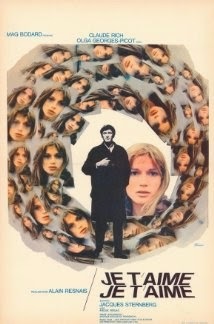
The French love memory. Proust's masterpiece was A La Recherche du Temps Perdu, In Search of Lost Time or The Remembrance of Things Past, as it's most often translated. The French philosopher Henri Bergson" wrote a tome entitled Matter and Memory in which he distinguishes between "habitual" and "pure memory." Freud said dreams were "the royal road to the unconscious" and Bergson showed how certain kinds of mnemonic processes, perhaps like the Proustian madeleine, go beyond either the "habitual" or "pure" to open a door up on the past. Alain Resnais's Je t'aime, Je t'aime (l968) currently playing at Film Forum takes the form of a science fiction film and concerns a time machine. But it's crude science fiction at best and really just an occasion for the exploration of memory. Here Resnais continues the style of exposition he famously introduced in Last Year at Marienbad (l961) where flashbacks and repetitions (like that of the films title "je t'aime, Je t'aime") produce a skewed vision of illusion and reality. It's a project that also consumed two earlier films, Hiroshima Mon Amour (l959) and the documentary Night and Fog (1955). Resnais's central character Claude Ridder (Claude Rich), who is recovering from a suicide attempt, is recruited outside a mental hospital, primarily because he's someone, who cares little about living and is willing to risk a voyage into the past. In going back in time, the narrative inevitably plumbs the mystery of why he has attempted to take his own life. There's something mysterious about Marienbad and the same air of suspense hovers over Je t'aime Je t'aime, but it's the kind of suspense that accompanies the unfolding of memory in a psychoanalytic session. Thus, it's not clear if the death of Claude's girlfriend Catrine (Olga Georges-Picot), a quintessentially anhedonic character, is an accident or murder and both Catrine and Claude are linked thematically by their lack of desire to live. Mice are frequently used in experiments on memory and besides the film's inadvertent excursions into the neurological concepts of both episodic and procedural memory, the mouse is Je t'aime's one concession to hard science.
This was originally posted to The Screaming Pope, Francis Levy's blog of rants and reactions to contemporary politics, art and culture}
Artist Profile: Interview With David Crowell, Brooklyn-based Composer & Performer
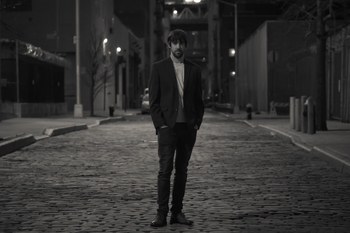
David Crowell is a Brooklyn-based composer and multi-instrumentalist who creates rhythmically complex music with an easy, almost floating quality to it. His work has been performed at numerous venues, such as the Museum of Modern Art and Carnegie Hall. As a performer, he tours as a member of the Philip Glass Ensemble, traveling the world from Houston to Budapest to play such Glass classics as Koyaanisqatsi and Einstein on the Beach.
His band Empyrean Atlas performs Crowell's music, and has recently finished recording their second album. His work with Empyrean Atlas has an African-music inflected style that also brings to mind Ornette Coleman's record Dancing in Your Head.
Crowell has an upcoming performance of a new work entitled Celestial Sphere, which was commissioned by Ian David Rosenbaum and a consortium of percussionists. Rosenbaum will perform it on March 23rd at the Philips Collection in Washington D.C.
Crowell also has an upcoming concert on March 24th at Roulette in Brooklyn, performing with his band Empyrean Atlas and sharing the bill with Victoire, Build & itsnotyouitsme.
I interviewed him while he was traveling and performing in Berlin.
JG: What are you doing with your compositions? What are you working on?
DC: My major project right now is finishing the second Empyrean Atlas album. At this point, it's close to done and I'm really happy with the result. For the new record I switched from saxophone to guitar, so the instrumentation is three electric guitars, bass and drums. The music is inspired by the work of Zimbabwean artists Thomas Mapfumo, The Four Brothers, and Oliver Mtukudzi (primarily the album Tuku Music), as well as the composer Steve Reich and the saxophonist/composer Steve Coleman. The common thread with all these musicians is an intense focus on rhythm, unique melodic phrasing and counterpoint. The goal was always to create music with an original sound, though, even if it's interesting to analyze influences in hindsight.
In addition to Empyrean Atlas, I'm working on a new commissioned piece for the German ensemble SPARK, who released their latest album on Deutsche Grammophone. This group features two virtuoso recorder players. They're very popular in Europe, performing 60+ concerts a year, and the piece I write will become part of their touring program in 2015. I'm excited to work with them!
Lately I've also been conceiving of some new music for multiple alto/soprano saxophones & flute, which I would play and record myself. I've done some of this in the past, including a piece, Eucalyptus (for alto saxophones + electronics), that I performed several times at the New York Museum of Modern Art in 2011. I often record and mix my own projects. It's interesting to investigate how engineering and mixing decisions shape the final product.
For more info or to download the first Empyrean Atlas album, visit empyreanatlas.bandcamp.com
JG: What are you up to with the Philip Glass Ensemble?
DC: Right now the Philip Glass Ensemble is in Berlin, and we are getting ready to perform the final run of Einstein on the Beach. In the past two years, we've been all over the world with this production -- Ann Arbor, Montpellier, Reggio Emilia, London, Toronto, Brooklyn, Berkeley, Mexico City, Amsterdam, Hong Kong, Melbourne, Los Angeles, Paris, and now finally, Berlin. Due to the enormous complexities and finances of producing Einstein on the Beach, this is the last time the original creators -- Robert Wilson, Philip Glass, and Lucinda Childs -- will ever be involved. It's been an honor working with them, and the rest of the company, to bring this masterpiece alive one last time.
Then later in the month, we're going to Budapest for a performance of La Belle et la Bete, Philip's score to the classic 1946 Jean Cocteau film. And coming up in a few months is a performance of Music in 12 Parts, in Los Angeles.
JG: Tell me more about Eucalyptus, and what is was like working on a project at the MoMA and performing there.
DC: The MoMA asked me to do several performances in collaboration with Carlito Carvalhosa's exhibition Sum of Days. One of Carlito's primary goals for the installation was to alter visual and audio perception as a method of generating new insight, to be accomplished by full immersion in his environment. I felt that concept was something I could relate to musically.
So in thinking about the piece, I started with the physical space of not only Sum of Days, but the MoMA itself. The atrium, where the exhibition was installed, reaches from the second floor all the way to the top of the museum, about six floors high. I imagined a sound that would fill up the space, and hit on the concept of consciously utilizing the overtone series. So, at the beginning of the piece you hear two sets of the same three note chord overlapping, but you also hear a number of prominent pitches above and below those notes. They are manipulated in subtle ways electronically to enhance the effect. The sound is a bit otherworldly, a big sound for a big space!
JG: What is it like working with Philip Glass?
DC: It's been amazing, a great learning experience. I've been touring with the Philip Glass Ensemble since October 2007 -- although compared to founding member Jon Gibson, who has performed Philip's music since 1968, it's only a drop in the bucket! Or Michael Riesman, our musical director/keyboardist, who joined in 1974 and is completely integral, on many different levels, to the presentation of Philip's music. Because of low turnover in the ensemble, specific performance practices have developed between a small group of people. Some of it is represented notationally, but a large part of it isn't. It's quite a special thing.
The repertoire we play, with a few exceptions, ranges from 1968 to the early 80's and is composed specifically for the ensemble, or an augmented version of the ensemble. While there are many great pieces, including Einstein on the Beach, I think the heart and soul of the PGE repertoire is Music in Twelve Parts. It's like playing the hardest concert you've ever done in your life, four times in a row. It's completely fantastic!
JG: Do you consider yourself a Minimalist?
DC: I definitely don't consider myself a Minimalist, although certain pieces (including Eucalyptus and some of the other compositions on that same album) have some of those tendencies in them. By definition, classic Minimalism is primarily a process based compositional form, and I prefer to write intuitively.
JG: What is the state of Minimalism in music today?
DC: I'm not sure I know of many Minimalist composers around today, other than the original crew. But their influence is felt far and wide. Broadly speaking, I think that lineage was passed down first to composers like Michael Gordon, Julia Wolfe and David Lang, of Bang on a Can, and from them to my generation. I think we look at those concepts as one useful tool, among the many available.
JG: What is life like for a composer in Brooklyn?
DC: Life is pretty good! In New York City, and Brooklyn in particular, there is an explosion of music happening right now. In fact, there's so much, I discover amazing new things on a regular basis. Part of the fun is seeing your friends and colleagues push themselves creatively, and in turn allowing that energy to inspire you. So as a composer (and a performer), there is an endless resource of people to collaborate with.
JG: How does improvisation influence your music? Do you use improvisation in your compositions?
DC: I'd say most of the time my music is completely composed. But having studied improvisation for many years, and knowing musicians who have done the same, I'm aware of how to write for improvisers, how to utilize their individual strengths/voices, and what special elements it can bring to a piece of music. These days, most of that takes place in Empyrean Atlas. Even then, I'd say 90 percent of the EA music is composed. But we've hit on a specific way of improvising, which includes a textural ambient element, and a concept of staying with a feeling or an idea, without the energy of trying to develop it. Sometimes this involves actually playing written parts, but in a certain way, or with small variations. It's a little abstract, I know, kind of hard to explain, but one of the great things about working with the same people for awhile is you develop this way of feeling music together, consciously and unconsciously. Sometimes you talk about it, and sometimes you don't.
I'd also say, a little more concretely, that the role of our drummer, Jason Nazary, is pretty interesting. I don't write out full parts for him, like I do for everyone else. We use sketches and rehearsal to get to a part that feels right.
JG: Tell me more about Empyrean Atlas and how that group and album came to be.
DC: Empyrean Atlas evolved organically out of previous projects, and from a circle of musicians that I've been working with for as long as 15 years (dating back to my time at the Eastman School of Music). These are people I know well, as musicians and as friends. It took a few years of writing and playing the music live to really understand what EA was about. In making our first record, we were able to codify some of the concepts and sound of the band, and I was able to see pretty clearly how to move forward with writing new music. In some ways, the feel of the second album is quite different, but if you listen to both of them they definitely make sense together, like two sides of the same coin. It's exciting to me, to have a project like this, that can develop over a period of time. I can't wait for the new album to come out, and for people to hear it.
JG: Tell me about your works for chamber ensemble.
DC: A few months ago I finished a piece, Celestial Sphere, for Ian Rosenbaum and a consortium of percussionists. Ian is performing it in a few weeks at the Philips Collection. This is one of those projects I talked about earlier where I also engineered and mixed. It's a lot of work to do everything, but completely worth it, especially with someone like Ian playing! In this case, the composing process bled quite a bit into the editing/mixing of the piece. I was able to make some significant changes, after recording, that completely altered the direction of the music.
Fairly recently I had the opportunity to work with some heroes of mine, Alarm Will Sound. If you don't know about this ensemble, you have to check them out. The piece I wrote for them is called Fallout. We were talking about improvisation before, and this piece has a solo at the end for Caleb Burhans. Knowing Caleb and his playing gave me the confidence to include the improvisation, which I wouldn't have done otherwise. The whole piece itself is kind of an experiment, a cut up of very different sections put together, with the challenge of making each transition flow in a reasonably coherent fashion. I also mixed this, from a live performance in Columbia, Missouri.
Over the years, I've developed a nice working relationship with the JACK Quartet, who are probably most famous for their Xenakis recording on Mode, but who do many different things very well. They are an amazing string quartet. Last year, they premiered a new composition of mine for string quintet, with Mak Grgic on guitar. Around the same time I had a premiere of a piece, Hashimoto, for three flutes at Weill Hall, performed on the recording below by Andrew Sterman. And Waiting in the Rain For Snow is a piece I wrote for the excellent NOW Ensemble, which they recorded for their second album on New Amsterdam Records.
JG: How do you categorize your music? Is it classical, pop, something else completely?
DC: When I listen to someone's music, I'm searching for their personality, feel, and what they're trying to say. If I know them, does their music seem to make sense with who they are, or at least who I perceive them to be? If not, or if so, why? If I don't know them, what does their music tell me? Are their intentions genuine, calculated, or some combination of both? Are the heart and the intellect interacting on an equal level? A lot of times these questions are impossible to answer, but it's fun to try.
I saw a recent interview with Philip Glass, and he said that music is a place you can go to, an actual place in your mind, and I think this is a great way to think about it. When I listen to a new piece of music, live or on record, I want to go to a place I haven't been before. The power and honesty of a musician's creativity is related to how vividly you experience that place. I think this is the best way to think about genre.
***
Hear David Crowell perform with his band Empyrean Atlas on March 24, 2014 at Roulette in New York City
To hear more music, buy a CD and get more information, visit www.davidcrowell.org/
***
Subscribe to get new articles by Joel Garten in your inbox. Click Here.
Joel Garten is a composer, pianist, artist, and writer. You can view his artwork and listen to his music on his website, www.joelgarten.com
Other articles by Joel Garten you may enjoy:
Artist profiles of conductor Alex Pauk, pianist Vicky Chow, Composer Andy Akiho and pianist Claudia Chan, percussionist Ian David Rosenbaum, and read about how Garten composed new piano music during Hurricane Sandy. You can also read Joel Garten's interview with MoMA Curator David Platzker about the John Cage Exhibition.
Add Joel Garten on Google Plus / Joel Garten on Facebook
This article was also published on the Arts Journal Fresh Pound
Photo by Felicity Palma
How 'Moonrise, Hernandez' Came to Be One of the Iconic Photographs of the 20th Century
The picture has three separate elements: the town of Hernandez in the foreground, a rim of clouds illuminated on the horizon by the setting sun and the glowing moon alone in the dark sky above.
Adams knew it was a great picture, but "he was never completely satisfied with the prints he was making," according to his grandson Matthew Adams, and so the photographer tinkered with them in the darkroom, producing more than 900 prints over the course of 40 years. "In 1948, he bathed part of the negative in a chemical intensifier in order to create more contrast in the foreground and to make the moon brighter. Before that, things had looked a little flatter." Over the years, the prints also became larger, moving from 16" x 20" or smaller up to 40" x 60". Ansel Adams himself said that, with all that tinkering and various alterations, "it is safe to say that no two prints are precisely the same."
Still, with hundreds of "Moonrise, Hernandez" prints out in the world -- often produced by Adams whenever an order for a copy came in, most of them done in the 1960s and '70s (Adams kept no records on what he did when, and no one knows just how many "Moonrise, Hernandez" prints were made) -- one would presume there is some way of measuring how much they might cost. By the year in which they were printed. By the square inch. Whether or not they are signed. With 900-plus prints out there, one can't claim rarity, right? Nothing is that easy. Christie's auction house has one in its April 3 photography sale in New York (titled "The Range of Light: Photographs by Ansel Adams"), printed in 1973 and estimated at $50,000-70,000.
That print is 16" x 20," the most common size in which that image was printed, mounted on a larger board and signed by Adams somewhere on the mount. There is a more rare group of prints at the "mural size" (Adams' term) of 30" x 40," which often were made for specific projects, such as Polaroid wanting a "Moonrise, Hernandez" for one of its corporate offices. The mural sized prints were "flush-mounted" onto wood, masonite or on a type of fiberboard called Homosote, and Adams made his own thin wood frames for them.
The mural-sized prints were also unsigned, because there was no mount on which to put a signature. However, Adams would sign these prints if asked.
While the Christie's "Moonrise, Hernandez" is not likely to break $100,000, half a million dollars wouldn't be a record price for the work. A smaller (14" x 19") 1948 version earned $609,600 (estimate $150,000-250,000) at Sotheby's in 2006, and a 1950 mural sized print (39" x 56") from Polaroid's collection went for $518,500 (estimate $300,000-500,000) at Sotheby's in 2010. Yet other top public sale prices for "Moonrise, Hernandez" prints are $360,000 (a 1948 13" x 17"), $157,000 (a mid-1970s 18" x 23"), $120,000 (a 1960s 19" x 25"), $88,000 (a 1960s 15" x 19") and $66,000 (a c.1975 15" x 19").
Traditionally, black-and-white photography is valued in large part by whether or not a particular print is "vintage" -- meaning that it was created within a year or two or three (there are many definitions for what constitutes "vintage" among photography purists) of when the picture was taken. Adams did produce a couple of prints of "Moonrise, Hernandez" after returning to his studio in San Francisco, "but he found getting the image he wanted was incredibly difficult," Christopher Mahoney, senior vice-president in Sotheby's photographs department, said. "The exposure wasn't exactly right, the contrast level was off. It was a huge amount of hand work, burning and dodging to getting things looking right," and he might have given up completely. However, Adams sent "Moonrise, Hernandez" to a photography magazine in 1942, which published it, leading to numerous requests from, first, subscribers and later others who saw the photograph to buy a print. By 1948, Adams went back to the negative and began reprocessing it, "and we think of the modern era of the printing of 'Moonrise' beginning then."
The early prints of "Moonrise, Hernandez" showed what Adams actually saw that late afternoon in 1941, with the moon becoming visible in the sky while the sun was just sinking below the horizon; the moon was dim, while the sky was gray and open. In time, the photographer added more contrast, making the image far more dramatic, by brightening the moon while darkening the sky. Through repeated printings, Adams brought out the mystical vision that he spotted from his car years before.
Perhaps, part of the allure of this image is that Adams worked on getting this image just right for so much of his career. "This image encapsulates his career," Mahoney said, "and we can see in it his changing ideas and aesthetic style."
Rwanda: First-Ever Reality Show Zamuka Models Entrepreneurism

Search for Common Ground (SFGC), an international NGO, is hoping to inspire and launch a new generation of young entrepreneurs with Zamuka -- the first ever, Rwandan reality TV show. Unlike the reality show genre that dominates U.S. programming, this pioneering show is designed to encourage building a life beyond farming and agriculture. Heading into its second season, the reality show models entrepreneurism and encourages rural youth to take informed risks and find creative ways to earn a living. On the show, three contestants face challenges and are offered coaching to help them overcome a traditional culture of reticence in order to break into the business world as serious players.
Funded by the Belgian government, the show is produced locally as a partnership between Search for Common Ground and independent station TV10. Season 1 aired in November 2013 and featured three contestants: M. Noella Mugisha, 23, who aimed to launch a computer security business; Augustin Nsengiyumva, 27, who dreamed of starting a cyber café in his home district outside of the Capital; and Samuel 'Sam' Zizinga, 26, who envisioned an animation business to introduce cartoons using Rwandan culture as entertainment. At the end of the six episodes, an independent panel of experts named Sam the winner of $1,500 for the best idea and most feasible business plan.
The idea for the show came out of the realization that reality television can be a tool for change in emerging economies like Rwanda, which has been called the "Singapore of Africa" due to its relative stability and intense focus on creating a knowledge-based economy.
Rebecca Besant, Regional Director for SFGC said:
We developed the show because we had seen our colleagues do a reality TV show in Democratic Republic of Congo (DRC) around citizen engagement, and were very intrigued by how it spoke to the audience and motivated people to get involved in a different way. Rwanda has very limited local media, with almost nothing produced in the country for TV, so we wanted to see if we could introduce an innovative format that could get people excited about a really relevant topic in the country-youth livelihoods and entrepreneurship.
Zamuka, which starts its second season in March, is continuing its quest to drive home the importance of entrepreneurism to young people. Besant added:
We are hoping that the show encourages young people to take informed risks: we want them to think outside the box about what they can do with their knowledge and skills, but also to think through what they need to put in place to be successful as business entrepreneurs. The show is a mix of encouragement and caution in that way.
Check SFGC for air dates and times.
The Most Powerful Painting I Have Ever Seen... And How it Freed Someone From Prison
My good friend and colleague, Anthony Papa, found his passion for art while serving a 15-to-life sentence in Sing-Sing. Papa painted hundreds of pieces while behind bars, but one of them stands out and is the most powerful painting I have ever seen.
Papa's self-portrait, "15 to Life" is haunting and causes a wave of emotion every time I see it. The piece shows Papa looking into a mirror with his hands clasping his head. He is looking into the mirror realizing that he is going to spend the most productive years of his life in a cage. The expression on his face, and the regret and fear in his eyes is chilling.
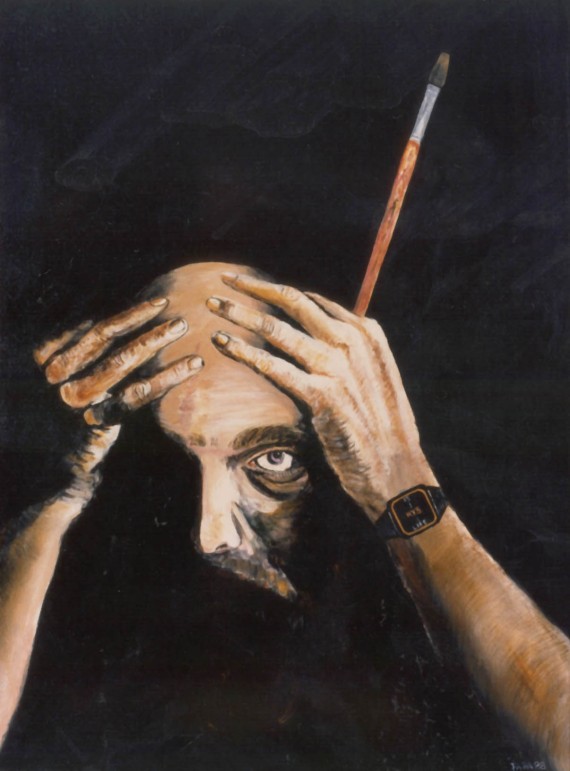
Papa was sentenced to 15 years to life for a first-time nonviolent drug offense. One of his friends got busted for drugs and had to entrap others to reduce his sentence. He convinced Papa to pass an envelope with four ounces of cocaine, a deal that would net Papa $500. Papa finally agreed and when he arrived with the envelope, he had 20 cops waiting for him.
In year six of Papa's incarceration, he found his passion. Painting not only gave Papa something positive to do while behind bars, it would introduce his plight to the outside world, get him clemency and free him from prison.
In 1995 the Whitney Museum was looking to feature art by prisoners. Papa's "15-to- Life" piece was selected. It generated press attention in the New York Times and other outlets.
Papa realized that this painting and the attention from the Whitney could help bring attention to his story. One problem was that the Whitney didn't use his name when they displayed Papa's piece, but only used the title 15-to-Life. Papa had to figure out how to let people know that he was the painter.
He decided to do his own PR. He sat in his jail cell and wrote out his whole story, including his piece showing at the Whitney Museum. He mailed his pitch to theWestchester Journal which did a profile on him. Others picked up on his story until it was picked up by the New York Times. Finally, after a wave of press, then-Gov. George Pataki granted Papa clemency in 1997, 12 years after he was sent to prison.
Papa had painted his way to freedom.
But Papa's story doesn't end there. Once Papa was freed, he decided to dedicate his life to changing the laws that incarcerated him. Papa and comedian Randy Credico founded a group called Mothers of the New York Disappeared and organized families that had loved ones incarcerated. They held vigils and protests where moms and dads, brothers and sisters would hold up photos of their loved ones who were serving long mandatory-minimum sentences on low-level drug charges. They changed the image of who serves time. These weren't kingpins, these were peoples mothers and brothers rotting away for small amounts of drugs.
The Mothers teamed up with groups like the Drug Policy Alliance and hip-hop mogul Russell Simmons to mobilize against the Rockefeller Drug Laws. Russell Simmons brought together Jay Z, P-Diddy, 50 Cent and more to speak out and thousands came out to see them slam the drug laws.
In 2009, 36 years after the birth of the Rockefeller Drug Laws, the laws were reformed. I was at the event where Gov. David Paterson signed the Rockefeller Reform Laws. The photo of Papa hugging Gov. Paterson still makes me emotional.
Papa not only painted his own way to freedom, he helped change the laws to free the people he left behind.
Tony Newman is the director of media relations at the Drug Policy Alliance.
This piece first appeared on the Drug Policy Alliance blog.
Brothers Hypnotic -- An Inspiring Documentary About Music, Politics, and Family
For the next 84 minutes, we travel with this incredible group of musicians -- the Hypnotic Brass Ensemble -- from the streets of New York to concert halls in Europe, interspersed with footage of their early days growing up in Chicago as the sons of legendary jazz musician, composer, and activist Phil Cohran. It is a remarkable journey. First-time documentary filmmaker Reuben Atlas captures the group's inspiring human, musical, and political evolution, viewing them as individuals as well as a "band of brothers," dedicated to each other and to their blend of jazz, hip-hop, and funk music.
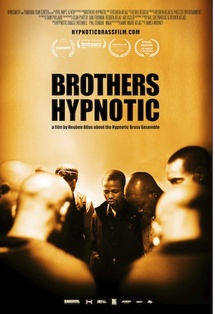
The film has already been shown at many film festivals, capturing awards along the way, but its first commercial screening will take place next week in New York City at the Maysles Documentary Center (343 Lennox Avenue at the corner of Malcolm X Boulevard) from Monday, March 24 through Sunday, March 3o at 7:30 p.m. Director Reuben Atlas and members of the Hypnotic Brass Ensemble will participate in post-film Q&As following the shows on Friday, March 28 and Saturday, March 29.
The film will also be shown on PBS's Independent Lens series next month but on different dates across the country. Check here for listings in your area.
The Hypnotic Brass Ensemble is composed of eight real brothers (one them was missing from the opening shot) who were raised in Chicago by their father and three mothers on a strict diet of jazz, funk and Black Consciousness. The film depicts their upbringing, their music, their efforts to maintain their artistic and political integrity, and their friendship and concert gigs with artists like Mos Def, Blur and Prince.
Atlas spent several years filming the brothers and their family members, clearly gaining their trust, but without compromising his own artistic independence.
You've never seen a documentary like this. Brothers Hypnotic is not a concert film -- like Woodstock and Jonathan Demme's Neil Young Journeys -- but a documentary about how eight individuals forged a collective musical enterprise in a society and industry that rewards individualism, competition, and celebrity. It is about race, politics, music, and family. It is both cerebral and celebratory. It doesn't hammer the audience with a big-M message except that art and life are complicated and full of surprises.
Their father, trumpeter Phil Cohran, played with Earth, Wind & Fire, Sun Ra, and many other musical giants. From his home base in Chicago, Cohran was also an important figure in the black consciousness movement, organizing concerts and political rallies that triggered surveillance and repression from the Chicago police department and the FBI, which Atlas reveals through interviews and archival footage, including a clip of Stokely Carmichael speaking at a Cohran-organized event. In the 1960s, Cohran was instrumental in founding the Association for the Advancement of Creative Musicians, an important influence in jazz's complex mosaic. But throughout his zig-zag career, and with the support of his three musically-gifted wives, Cohran instilled his dedication to politics and music in his children, now in their 20s and 30s.
The film documents but does not judge Cohran's unorthodox living arrangement with his wives and many children. Atlas uncovered old home movies of the siblings' unusual upbringing, including their daily 6 a.m. before-school practice sessions with their stern father, whose musical genius, personal discipline, and political awareness left a permanent imprint on his sons. Atlas gives their father and mothers opportunities to explain their efforts to mold the children's musical, personal, and political awareness, which could have suffocated them but instead instilled in them a powerful bond. Only the boys, however, transferred their musical genius and sibling loyalty into their collective voice as the Hypnotic Brass Ensemble. The three daughters went their own ways.
Atlas doesn't spare us the group's occasional generational rebellions and sibling rivalries, but Brothers Hypnotic is mainly about their music -- their remarkable talent, their quest for recognition, their musical differences with their father, and their ambivalence about commercial success without compromising their artistic and political integrity.
We see the band playing for tips on the New York streets, in clubs, at Lincoln Center, in the recording studio, and on a concert tour in Europe, hanging out in each other's homes, ruminating on their unusual upbringing, and creating their musical magic. Atlas captures their joy in playing with each other and with artists like Prince and Mos Def, but also shows the difficulties of molding their careers as part of a group when each member has his own life, including (for several members) wives and children. Atlas makes sure that we see them as individuals, as members of the music group, and as part of an extended family.
Regardless of your tastes in music, you can't help but love the brilliant sounds that emerge from the Hypnotic Brass Ensemble's instruments. You'll be mesmerized by the group's interactions -- full of humor, tension, and philosophical musings about family, art, and politics. Atlas helps the audience see the ensemble's place in history, including the political and musical arc that includes the ties between the various strands of the civil rights and black consciousness movements and the sounds of blues, jazz, R&B, funk, and hip-hop. Atlas never loses sight of the hard work that goes into composing and playing music, scheduling concert gigs, and negotiating with managers and record labels.
"Brothers Hypnotic will restore your faith in humanity," wrote a reviewer for CBS, "bring a tear to your eye, a heavy stomp to your right foot and, possibly, make you curse your parents for not forcing you to wake up at the crack of dawn for tuba practice."
Hopefully, too, Brothers Hypnotic will help catapult the Hypnotic Brass Ensemble, and filmmaker Reuben Atlas, into greater public awareness, so that more music- and movie-lovers can enjoy their astonishing talents.
Directed by Reuben Atlas. Produced by Reuben Atlas and Sam Pollard. Camera (color, HD), Sean Porter, Ari Issler, Dan Fridman, Reuben Atlas; editor, Keiko Deguchi. With Gabriel "Hudah" Hubert, Saiph "Cid" Graves, Tycho "LT" Cohran, Amal Baji Hubert, Jafar Baji "Yosh" Graves, Seba "Clef" Graves, Tarik "Smoove" Graves, Uttama "Rocco" Hubert, Phil Cohran, Maia, Aquilla Sadalla Graves, Mos Def, Damon Albarn, Prince, Tony Allen.
Peter Dreier teaches Politics and chairs the Urban & Environmental Policy Department at Occidental College. His most recent book is The 100 Greatest Americans of the 20th Century: A Social Justice Hall of Fame (Nation Books, 2012).
Belo: Canada's Artist with a Cause
Like many artists, Belo's art comes with an important message (famous street artist Banksey comes to mind). Belo makes beautiful things to help protect all the beautiful things around us, is how I like to think of his art.
Case in point, a 66,000 cup, 3,600 square foot water mosaic Belo created to draw attention to the lack of access to clean water that plagues much of the world:
Then there is Belo's "Citizen Tree" - another massive art piece Belo created in a parking lot using 100,000 public transit passes to draw attention to the negative impacts cars have on our lives:
Belo's work in progress at the moment is the "Guardian Tree" being built as part of Greenpeace's #StandforForests campaign, an awareness project to protect Canada's Boreal forests (those are the big ones in the North) from reckless clear-cutting.
No cool video on the project yet, but here's some images someone sent me:

In this one, you can see that he's added all the names of people, something like 50,000, who signed on to support the project:

Photo credit: Robert Wagenhoffer
What do you think? Have you ever heard of Belo?
Spring/Summer 2014 Styled By Fashion Experts
Four leading experts in the fashion industry spent a day styling looks from the Marks & Spencer Spring/Summer 2014 collection. They worked with two models and a hair & make up team to create four easy to wear looks that reflect trends we saw on the runway in September last year.
On the day Laetitia Wajnapel, the French force behind Mademoiselle Robot, said that when she first sees a new collection on the runway, she thinks about body shape and how the looks will work for real women.
Emily Johnston, founder of Fashion Foie Gras, said we have lots of buttoned up collars, oversized shapes and playful flirting with patterns to look forward to this spring.
The Looks:
Look one was a school-girl inspired outfit. Perfect for work or lunch with friends.
Look two was a playful day to night story.
Look three tackled the boyfriend jean, and won!
Look four was all about understated, relaxed elegance.
Text by Crane.tv
For more cultural news follow Crane.tv on Twitter or find us on Facebook or Instagram































